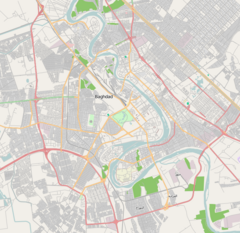Al-Wazeer Mosque (Arabic: جامع الوزير, romanized: Jami' al-Wazir) is an old mosque in Baghdad, Iraq, which is considered a cultural heritage building. The mosque was built by the Wazir of Baghdad Hassan Pasha in 1599 during the Ottoman era. Later the mosque witnessed several renovation and restoration works. The main characteristic of the mosque is its Ottoman architectural style.[1] It is located in al-Rusafa district behind the Souk al-Sarai, near the riverbank of the Tigris River.[2]
| Al-Wazeer Mosque | |
|---|---|
Arabic: جامع الوزير | |
 | |
| Religion | |
| Affiliation | Islam |
| Rite | Sunni Islam |
| Ecclesiastical or organisational status | Mosque |
| Status | Active |
| Location | |
| Location | Al-Rusafa, Baghdad, Iraq |
Location in Baghdad, Iraq | |
| Geographic coordinates | 33°20′21″N 44°23′19″E / 33.3392°N 44.3885°E |
| Architecture | |
| Type | mosque |
| Style | Ottoman architecture |
| Specifications | |
| Capacity | 400 worshipers |
| Minaret(s) | 1 |
The area in which the mosque is located in, as well as al-Wazeer Mosque itself, are a part of a tentative UNESCO World Heritage Site.[1]
Historical background
editThe site of the current mosque, which is located next to Souk al-Sarai and overlooking the Tigris River, used to belong to a previous mosque named "Dhu al-Manara Mosque" which dates back to the Abbasid Period. Iraqi historian Imad Abd al-Salam Rauf suggests in his book "The Bright Contract" that the location of a madrasa building that was built in 1106 during the reign of Seljuk Emir Muhammad I Tapar named "Tatchi-Baghdadi Madrasa".[3]
Construction on the mosque first began in 1599 under the supervision of Hassan Pasha who governed Baghdad under the Ottoman Empire between 1594 and 1603.[1] The mosque became known as "al-Wazeer Mosque" meaning "The Governor's Mosque". The Pasha renewed the architecture of the mosque and established a scientific madrasa that taught rational and communicative sciences. Among the most well-known teachers who taught at the mosque was the Sheikh Taha al-Sanwi who was also buried in the mosque.[3]
Later in 1604, a famous coffeehouse was built next to the mosque that overlooked the Tigris River and was named the "Hassan Pasha Café."[4] In 1686, an army officer named "Ahmed Agha" was ordered to rebuild the western side of the mosque. He also added a high dome and expanded it.[1] According to Iraqi historian Sherif Youssef, he mosque has been renewed multiple times throughout its history that its minaret remains the oldest preserved part of the mosque in its original form.[5]
The mosque was visited by British traveler and journalist James Silk Buckingham in 1816 during his visit to Baghdad and noted the mosque for its "fine dome and lofty minaret" in his 1827 journal "Travels in Mesopotamia".[6]
Architectural description
editAl-Wazeer Mosque is located in the heart of the Souk al-Sarai, near al-Mutanabbi Street. The mosque contains a traditional Iraqi minaret in addition to a dome covered with glazed tiles and marble. Inside, there are decorations consisting of stalactites and muqarnas decorated with Quranic verses and floral motifs. The entrance to the Mosque is a wooden door surrounded by yellow bricks and glazed with blue. Once entering the mosque, a wide courtyard that reaches more than 1000 square meters is found in the company with walls decorated with motifs and writings.[7] The mosque contains prayer space for over more than 400 worshippers. On the left side of the mosque, there is a round-shaped minaret. The attached garden extends to the riverbank of the Tigris river.[2]
The mosque was built on an area of 1000 square meters and it has two places for the summer prayer, which can accommodate about 330 prayers, and also the winter prayer room, which can accommodate 500 prayers. The mosque is considered one of the most beautiful mosques in Baghdad and it generated a folktale about its construction following a shipwreck on the bank of the Tigris River that set its location.[7]
Gallery
edit-
Al-Wazeer Mosque next to al-Asifyah Mosque, 2017
-
The mosque as of 2023
See also
editReferences
edit- ^ a b c d Historical Features of the Tigris River in Baghdad Rusafa, which extends from the school Al-Mustansiriya to the Abbasid Palace. UNESCO. Retrieved January 3, 2018.
- ^ a b مسجد الوزير. Masajed Iraq. Retrieved January 3, 2018.
- ^ a b الكيلاني ،السيد, ميعاد شرف الدين (2015-01-01). مدارس بغداد القديمة 941 - 1336 هـ / 1534 -1917 م (in Arabic). Dar Al Kotob Al Ilmiyah دار الكتب العلمية. ISBN 978-2-7451-8403-0.
- ^ Baghdad cafes, cultural life exchange, 1999
- ^ يوسف, شريف (2020-01-01). المدخل التاريخي لتاريخ العمارة العربية وتطورها (in Arabic). Al Manhal. ISBN 9796500428611.
- ^ Buckingham, James Silk (1827). Travels in Mesopotamia. H. Colburn.
- ^ a b https://tableegh.imamali.net/index.php?id=1471
